
The Vaksala Runestone, designated as U 961 under the Rundata catalog, is a Viking Age memorial runestone that is located close to Vaksala Church, near Uppsala, Sweden.

The Eggeby stone, designated as U 69 under the Rundata catalog, is a Viking Age memorial runestone that is located at Eggeby, which is 2 kilometers northwest of Central Sundbyberg, Sweden, which was in the historic province of Uppland.

The Viking runestones are runestones that mention Scandinavians who participated in Viking expeditions. This article treats the runestone that refer to people who took part in voyages abroad, in western Europe, and stones that mention men who were Viking warriors and/or died while travelling in the West. However, it is likely that all of them do not mention men who took part in pillaging. The inscriptions were all engraved in Old Norse with the Younger Futhark. The runestones are unevenly distributed in Scandinavia: Denmark has 250 runestones, Norway has 50 while Iceland has none. Sweden has as many as between 1,700 and 2,500 depending on definition. The Swedish district of Uppland has the highest concentration with as many as 1,196 inscriptions in stone, whereas Södermanland is second with 391.
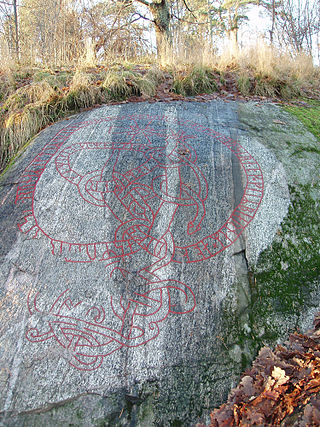
Runic inscription U Fv1986;84 is the Rundata catalog number for a Viking Age memorial that is located at Bo gård on the island of Lidingö in Uppland, Sweden.

U 1043 is the Rundata designation for a runic inscription on a memorial runestone located in Onslunda, Tensta parish, and about four kilometers west of Vattholma, Sweden, which was in the historic province of Uppland. While the tradition of carving inscriptions into boulders began in the 4th century and lasted into the 12th century, most runestones date from the late Viking Age.
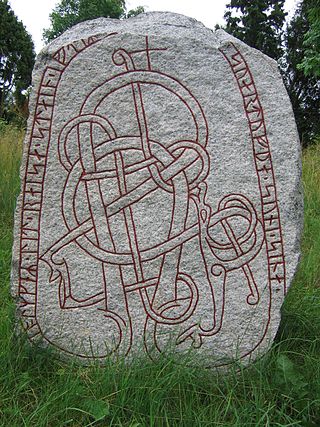
U 1014 is the Rundata designation for a Viking Age memorial runestone that is located in Ärentuna, which is about one kilometer east of Lövstalöt, Uppland, Sweden.
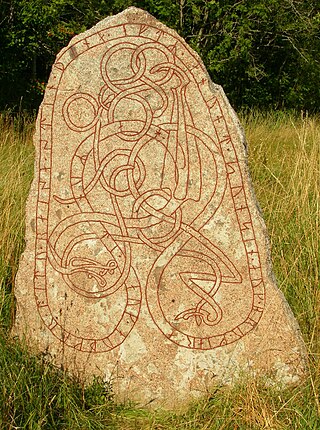
This runic inscription, designated as U 839 in the Rundata catalog, is on a Viking Age memorial runestone located in Ryda kungsgård, which is about 6 kilometers north of Enköping, Uppsala County, Sweden, and in the historic province of Uppland.

The Holmfast Inscriptions are two Viking Age memorial runic inscriptions and one image that are designated as Sö 311, Sö 312, and Sö 313 in the Rundata catalog. They are located in Södertälje, Stockholm County and the province of Södermanland, Sweden by the eponymous road Holmfastvägen.

Sö 328 is the Rundata catalog number for a runic inscription on a Viking Age memorial runestone which is located in Tynäs, which is about one kilometer east of Strängnäs, Södermanland County, Sweden, which is in the historic province of Södermanland.

The Björklinge runestones are five Viking Age memorial runestones designated in the Rundata catalog as U 1045, U 1046, U 1047, U 1048, and U 1050 that are located at the church in Björklinge, Uppsala County, Sweden, which is in the historic province of Uppland. In addition, there is a small fragment of a runestone with a partial runic text i * lit * rita * meaning "had erected" that has been given the catalog number U 1049.

Uppland Runic Inscription 181 or U 181 is the Rundata catalog number for a Viking Age memorial runestone located at Össeby-Garn, which is about one kilometer east of Karby, Uppsala County, Sweden.
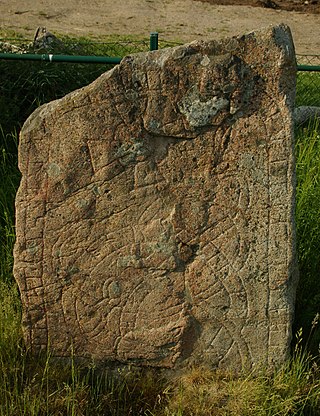
Uppland Runic Inscription 993 or U 993 is the Rundata catalog number for a Viking Age memorial runestone located in Brunnby, which is one kilometer west of Gunsta, Uppsala County, Sweden, which was part of the historical province of Uppland.

Södermanland Runic Inscription 178 or Sö 178 is the Rundata catalog number for a Viking Age memorial runestone which is located at Gripsholm Castle, Södermanland County, Sweden, which is in the historic province of Södermanland.
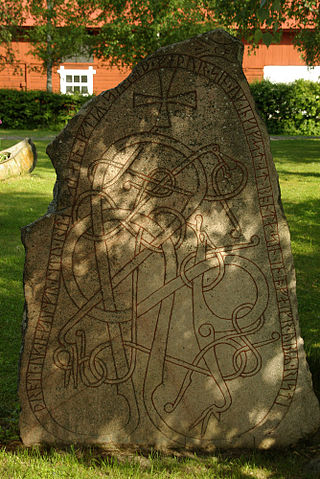
Uppland Runic Inscription 485 or U 485 is the Rundata catalog number for a Viking Age memorial runestone that is located in Marma, which is about six kilometers northeast of Knivsta, Uppsala County, Sweden, which was in the historic province of Uppland.
Uppland Runic Inscription 896 or U 896 is the Rundata catalog listing for a Viking Age memorial runestone originally located at Håga in the historic province of Uppland, Sweden, but is now at the Universitetsparken of Uppsala University.
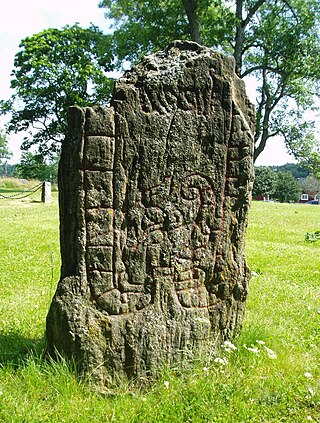
Södermanland Runic Inscription 239 or Sö 239 is the Rundata catalog listing for a Viking Age memorial runestone fragment that is located in Häringe, which is about one kilometer east of Landfjärden, Stockholm County, Sweden, which is in the historic province of Södermanland.

Uppland Runic Inscription 210 or U 210 is the Rundata catalog listing for a Viking Age memorial runic inscription which is carved on a rock-face that is located in Åsta, which is three kilometers east of Vallentuna, Stockholm County, Sweden, and in the historic province of Uppland. The inscription is signed by the runemaster Öpir.

Uppland Runic Inscription 541 or U 541 is the Rundata catalog listing for a Viking Age memorial runestone which is located at the Husby-Sjuhundra church, which is five kilometers west of Norrtälje, Stockholm County, Sweden, and in the historic province of Uppland. The inscription is signed by the runemaster Öpir.

The Bolsta Runestones are two Viking Age memorial runestones and two fragments of a third that are located in Bolsta, which is on the east edge of Uppsala, Uppsala County, Sweden, and in the historic province of Uppland. One runestone is signed by the runemaster with the normalized name of Åsmund Kåresson and the other by the runemaster named Öpir.


















